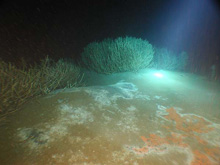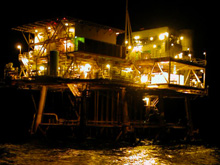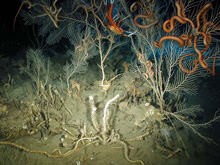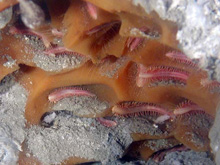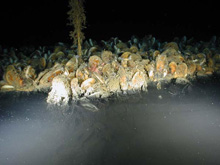Large tubeworm aggregations composed of Lamellibrachia luymesi and Seepiophila jonesi from 530 m depth at a seep site on the Upper Louisiana Slope of the Gulf of Mexico. In the foreground are mats of sulfide-oxidizing bacteria. Click image for larger view and image credit.
The BP Pompano oil platform in the Gulf of Mexico. Click image for larger view and image credit.
Mission Plan
Chuck Fisher
Penn State University
The primary purpose of Expedition to the Deep Slope is to discover and characterize the sea-floor communities that live in association with hydrocarbon seepage and on hardground in the deep Gulf of Mexico. The sites we will study are in areas where energy companies will soon begin to drill for oil and gas. Our mission will provide essential information on the ecology and biodiversity of these deep-sea communities to regulatory agencies and energy companies as the quest for oil moves into deeper and deeper water.
The largest oil reserves in the continental United States are found in the Gulf of Mexico. The Minerals Management Service (MMS) of the U.S. Department of the Interior oversees the responsible extraction of these natural resources. By the early 1980s, energy companies had developed the technology to explore and extract oil and gas from waters up to 1,000 m deep. During this period, MMS contracted the Geochemical and Environmental Research Group at Texas A&M University to study areas of the deep sea floor associated with active oil and gas seeps.
Although the original expectation of both the MMS and the scientists involved was that few animals would be found associated with these “toxic” sea-floor environments, early collections from these areas revealed amazing communities. When the trawls (the process of dragging a net through deep water to collect samples) over what would become known as Bush Hill came to the surface, they were so full of animals the nets could be brought on board only with the help of an extra crane. And the animals were not the usual denizens of the deep Gulf of Mexico. The collections were full of giant tubeworms and mussels, the likes of which had only recently been discovered at deep-sea hydrothermal vents in the Pacific Ocean. Since that time, similar (but different) cold-seep and hydrothermal-vent communities have been discovered in many different geological settings in all the world’s oceans.
This group of very old tubeworms (Lamellibrachia luymesi and Seepiophila jonesi) lives on the same piece of carbonate rock as large colonies of the gorgonian Callogorgia Americana americana. Note the brittle stars and a galatheid crab crawling on the gorgonians. Click image for larger view and image credit.
Iceworms (Hesiocaeca methanicola) infest a solid piece of orange methane ice at 540 m depth in the Gulf of Mexico. Click image for larger view and image credit.
Methane mussels (Bathymodiolus childressi), living at the edge of Brine Pool NR1 at 650 m depth in the Gulf of Mexico. The pool of brine in the foreground is nearly four times as salty as seawater and is so dense that the submarine can float on the pool to take pictures such as this. Click image for larger view and image credit.
Over the last 20 years, we have been studying these animals and communities at moderate depths in the Gulf of Mexico, along with the geology, geochemistry, and microbiology that allows them to flourish. As a result, the hydrocarbon seep communities in depths less than 1,000 m on the Upper Louisiana Slope of the Gulf of Mexico are the most intensively studied and best understood of any deep-sea cold-seep communities in the world. We now understand the basic biology of the dominant animals, their life histories, and the biodiversity and biogeography of the seep and coral communities on the Upper Louisiana Slope. We understand the successional processes that lead to the eventual development of coral communities on carbonates created during periods of active hydrocarbon seepage. We have also discovered some amazing new communities, such as those associated with iceworms that inhabit methane ice and mussels that ring the Brine Pool NR1.
Meanwhile, energy companies have continued to develop the technology for extraction of oil and gas from deeper and deeper water, and now have the capability to drill oil wells in all water depths in the Gulf of Mexico. Although several gulf hydrocarbon-seep sites at depths greater than 1,000 m have been visited by scientists, only a single site has been the focus of more than a few exploratory dives. This site, at 2,200 m in Alaminos Canyon, has lush communities of tubeworms and mussels that are reminiscent of the shallower sites that we know well. However, the underlying geology at this depth is different, as are almost all of the species present. Our preliminary studies indicate that the structure of the communities associated with the tubeworms and mussels is also quite different. The normal “background” fauna is different at this depth, and we expect different patterns of interaction between these animals and the seep-specific animals as well. Until we can identify what kinds of communities exist at depths between 1,000 and 2,200 m, we cannot begin to understand their ecology.
Our plan is to depart from Key West, Florida, early in the morning on Sunday, May 7, to begin our 36-hr transit to our nearest and first dive site. We expect to arrive in the early evening, and since we will be diving only during the daytime, we will begin with the night operations that are an essential part of our exploration program. At night, we will work from the deck of the ship, using box cores and bottom trawls attached to up to two miles of cable. We will use these devices to make collections of animals and sediments away from the immediate area of the seep sites. In the morning, we will begin our first circuit of dives at the newly discovered sites.
Starting at the easternmost sites, we will work our way west, then turn around and come back to the east, making a single dive at each of seven or eight new sites. We will dive every day, and move between sites at night. At times, we will be moving all night, while other night transits will only take a few hours, and the rest of the night will be spent conducting bottom trawls and taking box cores. At the end of this first leg of the cruise, we will review our discoveries and plan the dives for the remaining two weeks.
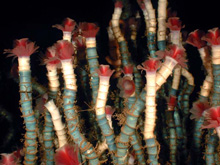
This image illustrates the growth of Lamellibrachia luymesi over 14 months in the Upper Louisiana Slope in the Gulf of Mexico. These animals were stained blue in June of 2002 and collected in August of 2003. The white tube above the blue is the previous year's growth. This kind of data allowed us to determine that this species of tubeworm can live in excess of 250 yrs, and will let us constrain the longevity of the new species we will discover at the deeper sites. Click image for larger view and image credit.
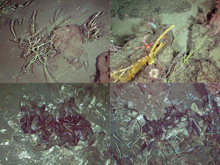
Four of 1,054 images of the sea floor at the GC852 site at 1,448 m in the Gulf of Mexico. Our first look at this site confirms the presence of Escarpia laminata, and what appear to be mixed beds of Bathymodiolus childressi and B. brooksi. There are also carbonates with bamboo corals and sea fans at this site. Click image for larger view and image credit.
Depending on the site, the extent of our studies will vary. At some sites, we will limit our activities to mapping the distribution of the animals and a limited set of chemical and geological characterizations, and collecting a small number of samples to provide us with baseline information about the site and its inhabitants. At other key sites, we will make multiple dives and thoroughly characterize the geology, geochemistry, microbiology, and biology of the sites. We will also establish longer-term studies at these sites, where we can determine growth rates of some of the animals, monitor for visitation by mobile deep-sea fauna (such as larger fishes and crabs), and follow the fine-scale changes in seepage patterns and community composition.
By the end of this expedition, we should have a much more complete picture of the biodiversity of the communities on the deep hardgrounds and seeps in the Gulf of Mexico, and their relation to the complex geology and geochemistry of the region. By the end of next year’s cruise, we will understand the dynamics, distributions, and biogeography of the animals and communities, including a vastly improved ability to predict their occurrence, based on geophysical, geochemical, and satellite data collected on and above the ocean surface.





























